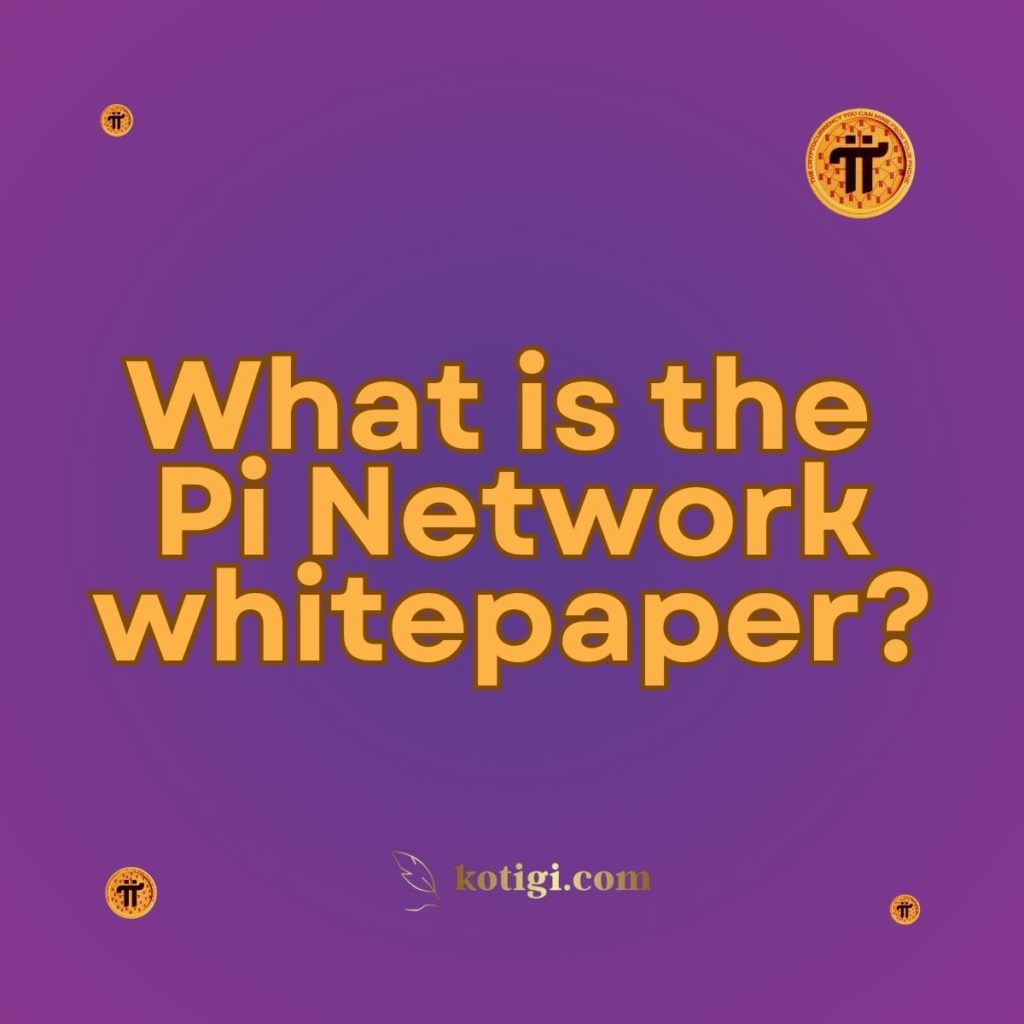
What is the Pi Network whitepaper?
The Pi Network whitepaper is a foundational document that outlines the vision, technical framework, and goals of the Pi cryptocurrency and its decentralized network. Serving as a roadmap for the project’s development, the whitepaper covers key aspects such as Pi’s consensus algorithm, decentralization principles, and the long-term vision for creating a widely accessible, scalable, and secure cryptocurrency for everyday users.
Introduction
For anyone involved in the world of cryptocurrencies, whitepapers play a crucial role in understanding a project’s mission, technology, and future plans. The Pi Network is no exception. The Pi Network whitepaper serves as the blueprint for the network’s development, detailing how it aims to create a decentralized digital currency that can be mined easily on mobile devices without significant energy consumption. But what exactly does the Pi Network whitepaper include, and why is it important? In this article, we’ll explore the key sections of the Pi whitepaper, what they mean for the network’s future, and how this document guides the ongoing development of Pi Network.
The Purpose of the Pi Network Whitepaper
Whitepapers are essential in the cryptocurrency world because they provide potential users, developers, and investors with an in-depth understanding of a project’s objectives, technical framework, and governance model. The Pi Network whitepaper is no different and serves as a comprehensive guide for those interested in the project.
Setting the Vision
One of the primary purposes of the Pi Network whitepaper is to clearly outline the project’s long-term vision. Pi Network aims to create a decentralized digital currency that can be easily mined by anyone using a mobile phone. This vision is a response to the increasing centralization of traditional cryptocurrencies like Bitcoin, where mining is largely controlled by a few large players due to the high costs of mining equipment and electricity. The whitepaper emphasizes making cryptocurrency accessible to everyone, especially people who may not have access to high-end computers or technical knowledge.
A Roadmap for Development
Beyond its vision, the whitepaper also serves as a roadmap for the network’s development. It outlines different phases of the project, including the Testnet, Mainnet, and eventual full decentralization. By offering a clear roadmap, the whitepaper helps the Pi Network’s community of users and developers understand the project’s current status and future plans.
Guiding Principles
The Pi Network whitepaper also establishes the guiding principles that shape the project’s governance, technical architecture, and user engagement. These principles include decentralization, scalability, and inclusivity, which are all critical to ensuring the long-term success of the network. The whitepaper makes it clear that Pi Network is built with the goal of avoiding many of the pitfalls that have plagued earlier cryptocurrencies, such as energy inefficiency and unequal access.
Technical Framework and Features
One of the key aspects of the Pi Network whitepaper is its technical framework. This section dives into the technical details of how Pi Network operates, including its consensus mechanism, decentralization efforts, and security protocols.
Consensus Algorithm: Stellar Consensus Protocol (SCP)
Unlike many cryptocurrencies that use energy-intensive proof-of-work (PoW) algorithms, Pi Network relies on the Stellar Consensus Protocol (SCP). SCP allows users to validate transactions based on a trust system among participants, rather than competing to solve complex cryptographic puzzles as in Bitcoin mining. This makes Pi Network far more energy-efficient and accessible, allowing users to mine Pi coins without draining their device’s battery or using expensive mining equipment.
The whitepaper explains that SCP is not only more sustainable but also more scalable than traditional consensus mechanisms. This is crucial for Pi Network’s goal of achieving mass adoption, as scalability will be key to handling millions, or even billions, of users in the future.
Decentralization and Nodes
The Pi Network whitepaper strongly emphasizes decentralization, one of the core principles of blockchain technology. As Pi progresses from its Testnet phase to the Mainnet, decentralization will become even more critical. In this regard, the whitepaper outlines how Pi aims to create a decentralized network of nodes. These nodes, run by Pi users, will validate transactions and secure the network without requiring centralized authority. The whitepaper explains how decentralization will empower users to contribute to the network’s growth and security, ensuring that Pi Network remains community-driven.
Security Features
Security is a fundamental aspect of any blockchain network, and Pi Network is no exception. The whitepaper provides detailed insights into the security features built into the network. These include cryptographic techniques used to secure transactions, prevent double-spending, and ensure data privacy. The whitepaper also addresses how Pi Network plans to stay ahead of potential vulnerabilities and security threats, further reassuring users about the network’s resilience.
Phases of the Pi Network
The Pi Network whitepaper outlines a phased approach to the platform’s development, which ensures that the network scales in a secure and sustainable manner. The whitepaper divides the project into several key phases.
Phase 1: Testnet
The first phase of Pi Network was the launch of the Testnet, which allowed the team to test the network in a controlled environment. During this phase, users could mine Pi coins on their mobile devices and form the initial network. The whitepaper explains that the purpose of the Testnet phase was to iron out any technical issues and ensure that the network would be stable and secure before moving to the next stage.
Phase 2: Mainnet (Current Phase)
The current phase of the Pi Network, as outlined in the whitepaper, is the Mainnet. In this phase, Pi transactions occur on a fully functional blockchain. The Mainnet represents a significant step toward full decentralization, as it brings the network closer to becoming a fully operational, peer-to-peer cryptocurrency platform. According to the whitepaper, one of the key focuses during the Mainnet phase is ensuring the scalability of the network while maintaining security and decentralization.
Phase 3: Full Decentralization
The final phase of the Pi Network, as described in the whitepaper, is full decentralization. At this stage, Pi will function as a fully decentralized blockchain where users, developers, and businesses contribute to its growth. The whitepaper outlines how this phase will involve not only technical upgrades but also governance changes, where the community will have a greater say in the network’s decisions. This phase will also see the introduction of more decentralized applications (dApps) and services that will drive the utility of the Pi cryptocurrency.
Governance and Community Involvement
Pi Network aims to be a community-driven project, and the whitepaper emphasizes the importance of governance and user involvement in shaping the network’s future. The governance model outlined in the whitepaper aims to give users a voice in critical decisions, such as protocol upgrades and the introduction of new features. The whitepaper suggests that Pi will eventually evolve into a fully decentralized autonomous organization (DAO), where decisions are made collectively by the network’s participants.
Voting and Consensus
As part of its governance model, the Pi Network whitepaper proposes that decisions will be made through a community voting system. This system will allow Pioneers to vote on important network upgrades, rule changes, and the direction of the ecosystem. The voting mechanism ensures that Pi Network remains true to its decentralized ethos, where users have an active role in shaping the platform’s future.
Developer Community
In addition to user governance, the whitepaper highlights the importance of a strong developer community. Developers play a key role in building dApps, improving the blockchain’s infrastructure, and creating new use cases for Pi. The Pi Network whitepaper outlines how the Foundation plans to support developers through grants, partnerships, and providing necessary tools to encourage innovation within the ecosystem.
The Significance of the Whitepaper for Pi’s Future
The Pi Network whitepaper is not just a technical document; it is a guiding force that outlines the future of the project. By providing a clear roadmap, detailed technical framework, and a decentralized vision, the whitepaper ensures that the network can grow sustainably while staying true to its core principles.
A Foundation for Trust
For any cryptocurrency, trust is paramount. The Pi Network whitepaper provides transparency about the project’s goals, technical details, and future plans, which helps build trust among its users. By laying everything out in a comprehensive document, the Pi Network Foundation ensures that users and developers have a clear understanding of what the project aims to achieve and how it plans to get there.
Long-Term Vision
The whitepaper also demonstrates the Pi Network’s long-term vision for creating a decentralized and scalable cryptocurrency. By addressing key issues such as accessibility, decentralization, and sustainability, the whitepaper positions Pi Network as a forward-thinking project capable of adapting to the evolving landscape of blockchain technology.
Conclusion
The Pi Network whitepaper is a critical document that outlines the vision, technical framework, and governance model of the Pi cryptocurrency. It serves as both a roadmap for development and a blueprint for how Pi Network plans to create a decentralized, scalable, and accessible digital currency. As Pi Network continues to grow, the whitepaper remains a guiding force, ensuring that the platform stays true to its principles of decentralization, inclusivity, and long-term sustainability.
Key Takeaways
- The Pi Network whitepaper outlines the project’s vision of creating an accessible and decentralized cryptocurrency.
- It details the technical framework, including the use of the Stellar Consensus Protocol (SCP) and plans for decentralization through a network of nodes.
- The whitepaper provides a roadmap that breaks down the development into key phases: Testnet, Mainnet, and full decentralization.
- Governance and community involvement are central to the whitepaper, with plans for user voting and developer participation.
- The whitepaper serves as a foundational document that guides the future growth and development of Pi Network, ensuring its scalability, security, and decentralization.





